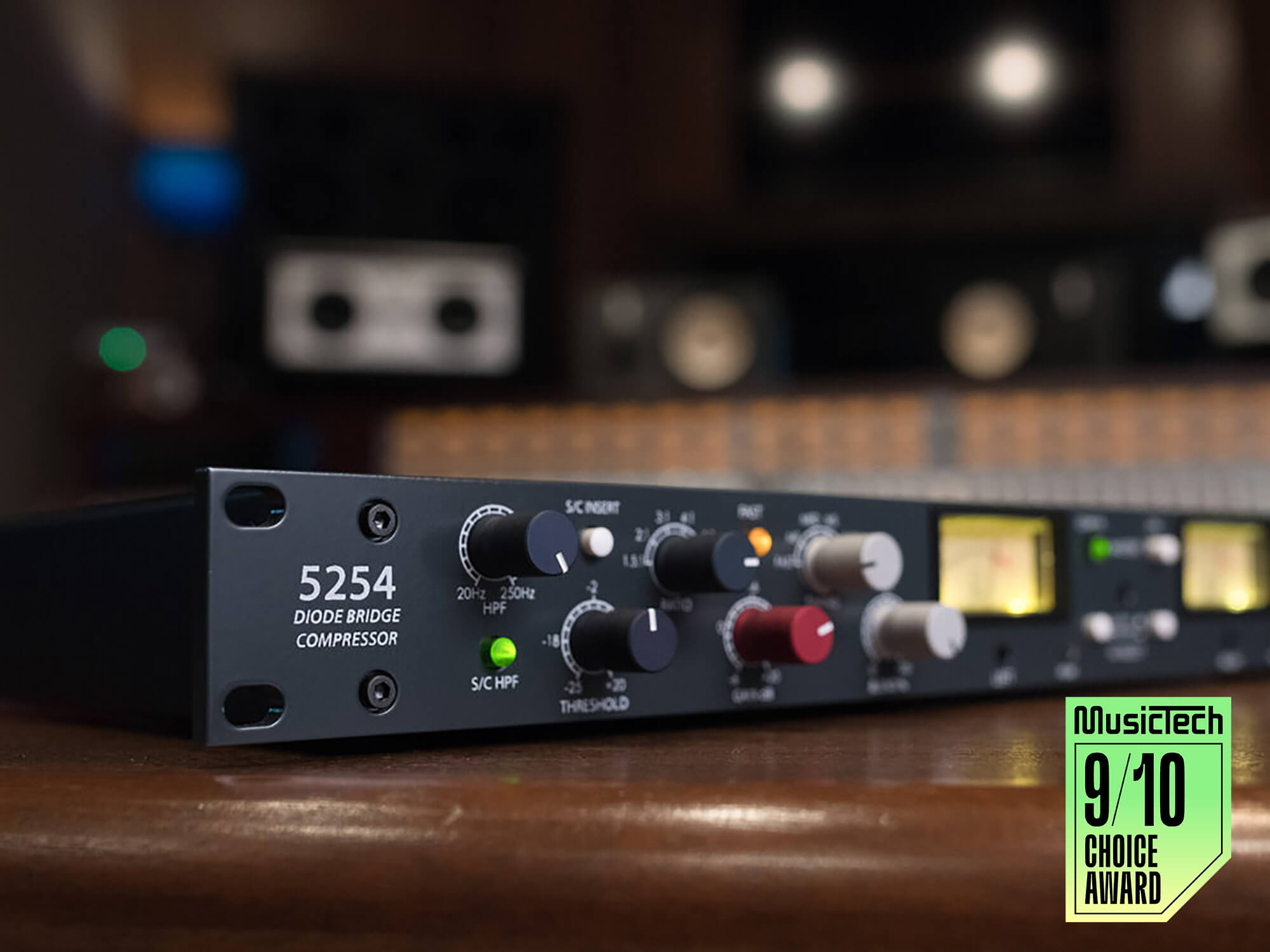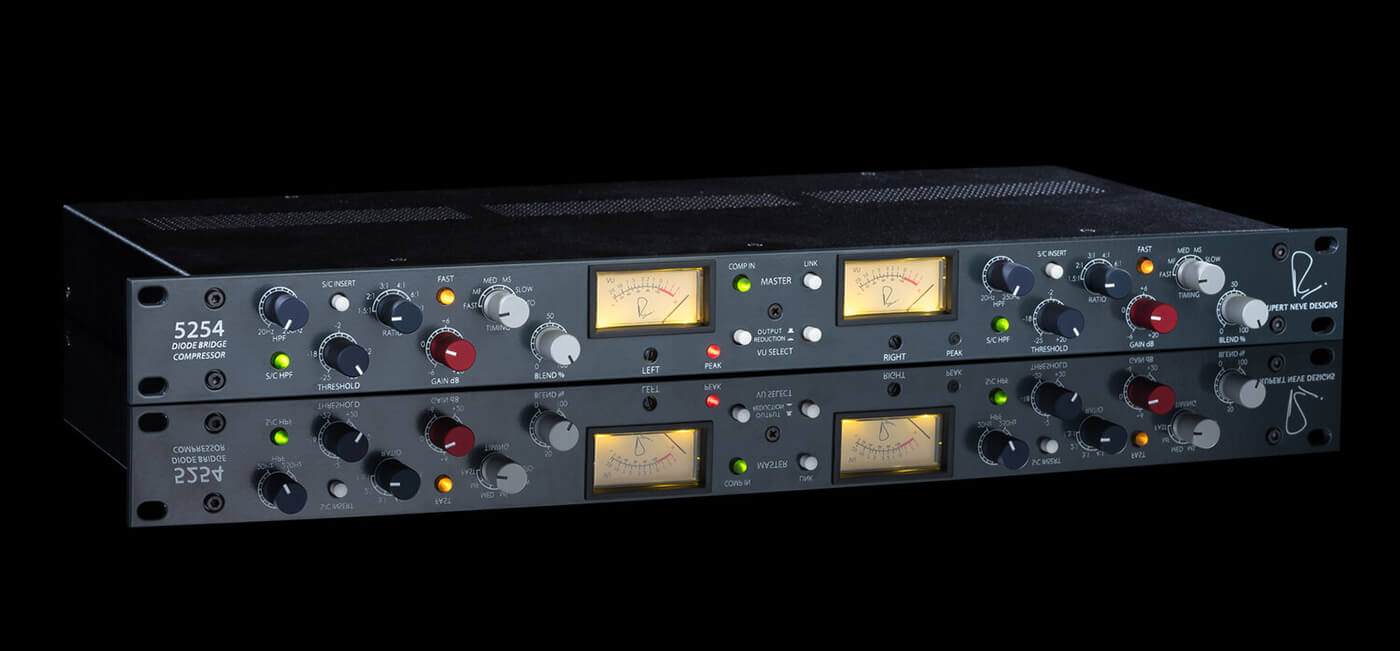Rupert Neve Designs 5254 Diode Bridge compressor review: VCAs and opto cells sit down, the diode bridge is back in town
With over 50 years of hard work under its belt the original Neve compressor circuit design gets a revisit from its late originator’s company.

Review Overview
Our rating
9
Our verdict
⊕ Can handle bass heavy sources even before the sidechain HPF is engaged
⊕ Highly flexible with twelve time constant ranges and six ratios
⊕ Blend knob for parallel compression
⊖ Quality comes at a price
⊖ Runs warm so needs a little rack space above
The 5254 dual-channel compressor bears all the hallmarks of the Rupert Neve Designs rackmount range: the extra thick dark grey front panel, powder-coated 31-position detented knobs, transformers visible through the enclosure venting grates and the steady warmth letting you know this is a Class-A unit. Adding light to the heat are a pair of illuminated VU meters for gain reduction and output monitoring duties.
The 5254 is not a recreation of 1969’s Neve 2254, but rather a reimagining, building out from the essential diode bridge level control. Out goes the limiter stage, high noise floor, half-wave sidechain detection and minimal compression recovery speeds. In comes sidechain high-pass filters, full-wave sidechain detection, twelve attack/release timing ranges, external sidechain inserts and a blend control for parallel compression.
The result is a modern compressor with vintage mojo on tap. The 2254 was known for its aggressive thickening effect but was limited by the noise floor, particularly on vocals. The 5254 expands the repertoire, ably handling vocals and delicate instruments, without losing the core appeal of the diode bridge compression behaviour for drums, guitars, bass and mixes.

The detented controls make the 5254 easy to apply to stereo sources without having to watch and listen for wonky meter readings. Whether it’s on the mix bus or a stereo group, the additional Blend knobs allow you to click your way into a balanced parallel compression. This requires tightly matched channels, and Rupert Neve Designs has delivered the accuracy and high headroom between the transformer-balanced inputs and outputs – as expected for the price. The transformer coupling that is central to all Neve gear imparts its own subtle brand of colouration, a gentle taming of the high end and some nip/tuck on the lows.
A high-quality compressor lives and dies by its sidechain detector, which in this case is the diode bridge. Operating in conjunction with the threshold, ratio and timing controls, this core component produces a remarkably wide range of responses. Exploring the behaviour of the 5254 is satisfying, thanks to the immediacy of the effects of adjusting and balancing the parameters. One useful quirk is that the Link switch sums the sidechain inputs for stereo use and extends the range of behaviours beyond mirroring the channels.

The Timing control provides six ranges for the attack/release time constants, with the Fast switch modifying these ranges to produce twelve combinations. Considering the threshold and ratio controls exert their own influence over the timing, it quickly becomes apparent that, despite there being gain reduction metering, using your ears is the only way to proceed, and it is a pleasure to do so.
The 5254 excels at adding bite to the transient edges of sources and clamping down in a controlled way while adding punch. Pushing this to extremes produces more distortion and aggression) which may be desirable on their own but, with the Blend control to hand, this provides an enhancement without killing the fundamental dynamic of the source. At times, the parallel compression accentuates the bite as the phase shift of the non-linear behaviour becomes audible in combination with the dry sound. All this is to say: the 5254 punches, kicks and spits, but in all the best ways.
Though the 5254 does away with the limiter stage of the 2254, it adds an 8:1 ratio that acts well as a limiter with faster timings and a carefully placed threshold. We may imagine compressor and limiter thresholds as defined lines in the audio sand, but they are more interactive than that when presented with complex signals. In this, the 5254 is no exception.
From the easy-going 1.5:1 ratio all the way up to the 8:1, there is considerable flexibility available from a gentle caressing of a mix to a full-blown transient assault on an arpeggiated synth. We may not know the actual time constants at play but the labelling is spot on with fast being very fast, and slow being…well, you know. The Auto timing is always worth trying out as it can produce an appropriately musical response to acoustic instruments, for example. The 5254 can be as forgiving as it can be severe.
We love bass and we don’t want our compressors to eat it all up – until we do. The 5254 is happy to do either, and the sidechain highpass filter keeps the low-end upfront even when things get squishy. Without the filter engaged, this compressor can ride bass-heavy sources remarkably. A fast compression can be achieved without losing low-end weight and there is plenty of scope for tightening up a bassy mix or holding a kick drum up in a dense track. For those wanting a pumped mix, or needing something accentuated in the sidechain signal, the S/C Insert switch brings the rear quarter-inch TS jacks into play for throwing in the bare kick track or inserting an EQ.
The 5254 effortlessly thickens and brightens signals, and nowhere is this more apparent than on electric guitars. There may only be 2dB of gain reduction showing in on the VUs, but what we can’t see are the peaks that get nibbled and bent. What we do get is a tighter, more solid instrument/group bus, and in a mix that’s important. Like all good things, it can be easy to overdo it with the 5254, so spinning the Blend knobs or hitting the Comp (bypass) switch can reacquaint ears with what life was like before getting over enthusiastic with this powerful compressor. It works exceedingly well as a dynamics processor, but it seriously impresses as a flavour enhancer. It is a lively and fulsome instrument of its own.
This is not a purchase to make lightly; serious equipment costs serious money. The quality of the build is high, as are the sonics, from the low noise floor to the excellence of the compression it delivers. The 5254 is a move forward for the diode bridge topology, not just a faithful recreation. The 5254 can earn its keep on the mix bus while also coming in handy on instrument busses. Then there’s tracking, an area where the upfront character of the 5254 can lift a performance, shape tone/dynamics and make a source pop before it’s even in a mix. This is a unique sounding professional tool at a professional price with far more range than it would seem at first glance.

Key Features
- Gain Reduction Ratios: 1.5:1, 2:1, 3:1, 4:1, 6:1, 8:1
- Timing Settings: Fast, Medium Fast, Medium, Medium Slow, Slow, Auto
- Timing Ranges: 250µS to 80ms (attack), 100mS to 2S (release)
- Line I/O: 2x XLR Combo (transformer balanced input), 2x XLR (transformer balanced output)
- Sidechain Insert: 2x 1/4” TS jacks per channel
- Sidechain HPF: 12dB/octave Sallen-Key, 20Hz to 250Hz
- Maximum I/O Levels: +26.7dBu
- Dimensions: 483mm x 209mm x 42mm
- £3299/$3599
- Contact Rupert Neve Designs
- Buy: Sweetwater, Thomann, Reverb